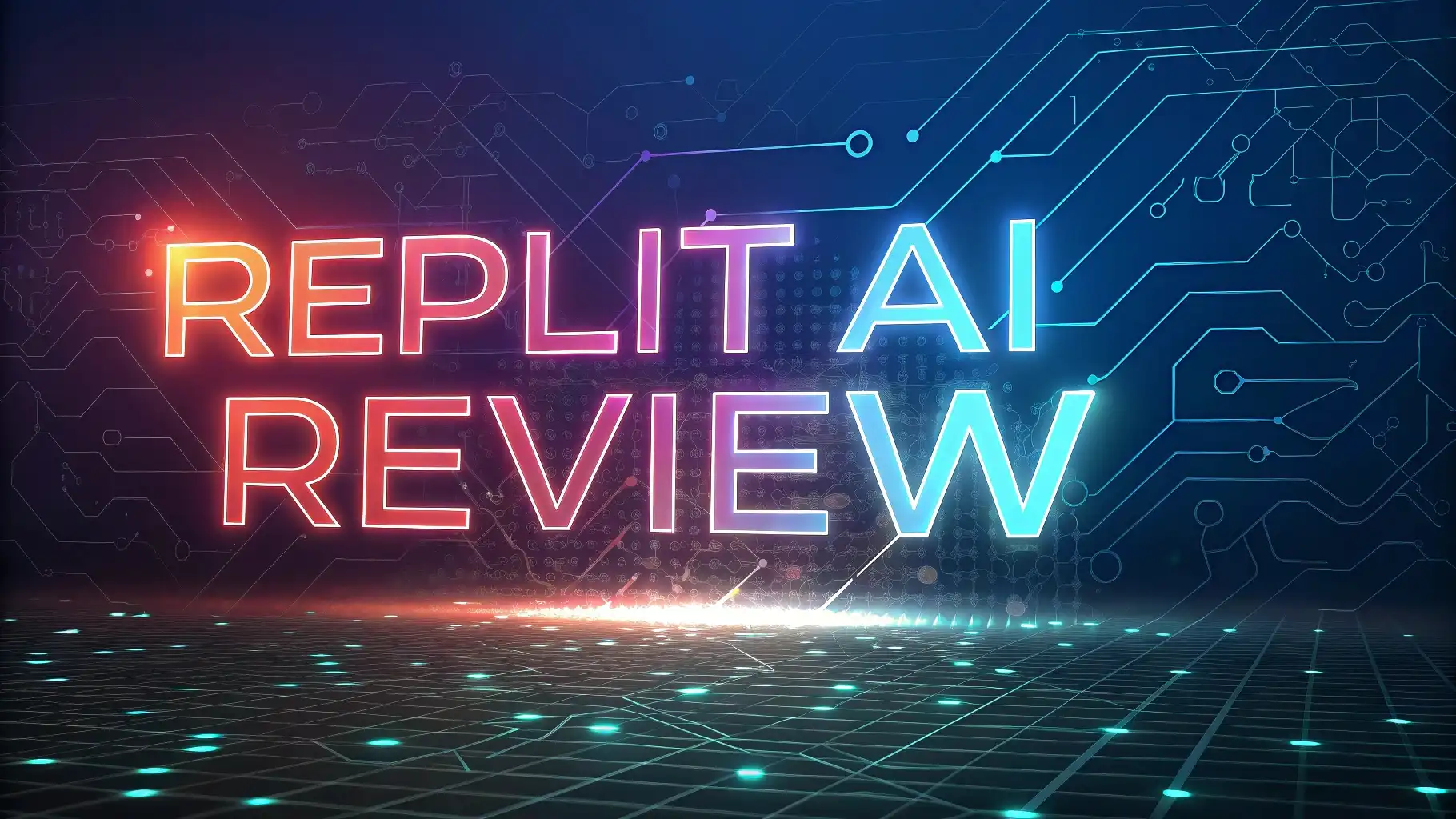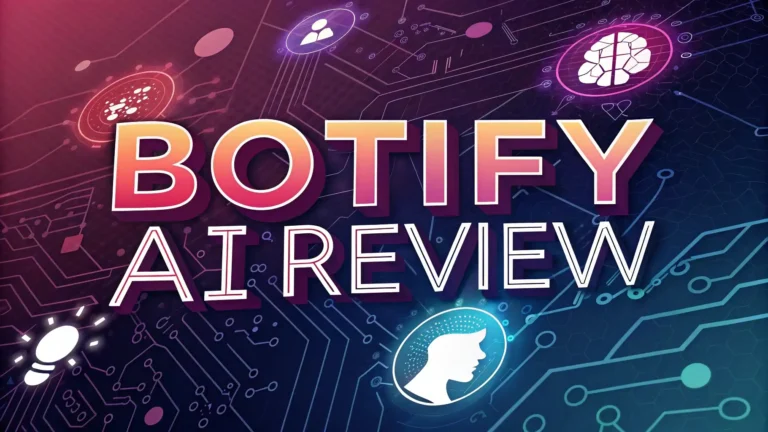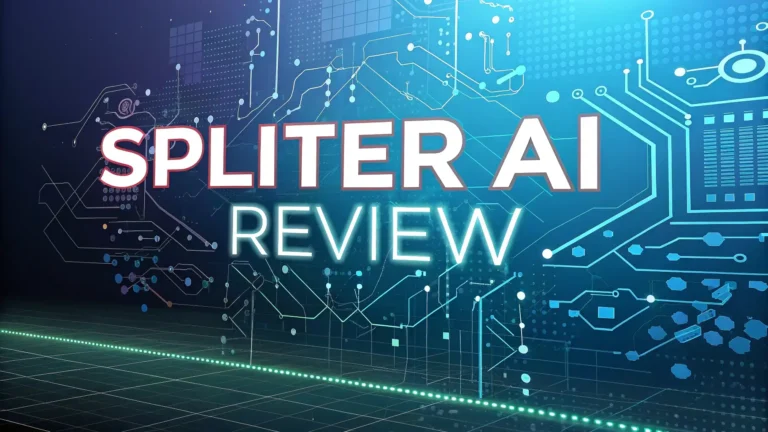Replit AI Review 2025: The Ultimate Guide
The world of software development changed dramatically in 2025. Replit AI emerged as a game-changing platform that transforms how we build applications.
Gone are the days when coding required years of programming knowledge. Replit AI makes app development accessible to everyone.
This comprehensive review examines every aspect of Replit AI to help you decide if it’s the right tool for your development needs.

Key Takeaways
- Replit Agent creates full-stack applications from natural language descriptions without requiring coding skills
- Transparent checkpoint-based billing ensures you only pay for meaningful progress made on your projects
- Built-in infrastructure includes databases, hosting, deployment, and security management in one platform
- Visual design capabilities allow you to build apps from screenshots or design inspirations
- Two-tier AI system combines Agent for creation and Assistant for refinement and improvements
What is Replit AI and How Does It Work
Replit AI represents a revolutionary approach to software development. The platform combines an online integrated development environment with advanced artificial intelligence capabilities. Users can describe their app ideas in plain English, and the AI system builds complete applications automatically.
The platform operates through two main AI tools. Replit Agent handles initial app creation from scratch. It takes your concept and transforms it into a working application with databases, user interfaces, and backend functionality. The process feels like having a conversation with an expert developer who understands exactly what you need.
Replit Assistant serves as your refining partner. After Agent creates your initial application, Assistant helps polish and improve your project. It handles updates, bug fixes, and feature additions without disrupting your existing workflow. This dual-system approach ensures comprehensive coverage throughout the development lifecycle.
The AI technology behind Replit uses advanced language models trained specifically for code generation. These models understand context, programming patterns, and best practices. They can work with multiple programming languages and frameworks simultaneously, creating cohesive applications that follow industry standards.
Core Features and Capabilities of Replit AI
Full-stack application development stands as Replit AI’s flagship capability. The platform creates complete applications including frontend interfaces, backend logic, database structures, and API integrations. Users simply describe their requirements, and the AI handles all technical implementation details.
Visual design integration allows users to upload screenshots or share URLs of designs they admire. The AI analyzes these visual references and recreates similar layouts and styling. This feature bridges the gap between design inspiration and functional implementation, making professional-looking applications achievable for non-designers.
Database management comes built into the platform. Replit AI can design database schemas, create tables, establish relationships, and populate data structures based on your application requirements. The system handles complex database operations without requiring SQL knowledge from users.
Environment setup and dependency management happen automatically. The AI configures development environments, installs necessary packages, and manages version conflicts. This eliminates common frustration points that traditionally slow down development projects.
Real-time collaboration features enable multiple team members to work on projects simultaneously. The platform tracks changes, manages conflicts, and maintains project consistency across collaborative sessions. Teams can build applications together regardless of their technical skill levels.
Replit Agent: Your AI Development Partner
Replit Agent functions as your primary development partner for creating applications from scratch. The tool excels at understanding complex requirements and translating them into working software solutions. Agent’s strength lies in its ability to handle ambiguous requests and make intelligent decisions about implementation approaches.
The conversational interface makes interaction natural and intuitive. Users can ask questions, request changes, and provide feedback throughout the development process. Agent responds with code changes, explanations, and suggestions for improvements. This creates a collaborative development experience that feels like working with a human developer.
Enhanced visual capabilities using React ensure applications look professional and modern. Agent automatically applies responsive design principles, accessibility standards, and user experience best practices. The resulting applications work seamlessly across different devices and screen sizes.
API integration capabilities allow Agent to connect your applications with external services. Whether you need payment processing, social media integration, or third-party data sources, Agent can implement these connections. The tool handles authentication, error handling, and data transformation automatically.
Replit Assistant: Refining Your Applications
Replit Assistant specializes in improving and maintaining existing applications. While Agent handles initial creation, Assistant focuses on iteration and enhancement. This tool understands your codebase context and can make targeted improvements without breaking existing functionality.
Direct code editing eliminates the need for copy-paste workflows. Assistant makes changes directly in your project files, maintaining code quality and consistency. Users can request specific modifications, and Assistant implements them while preserving the overall application structure.
Bug detection and fixing capabilities help maintain application quality. Assistant can identify potential issues, suggest solutions, and implement fixes. The tool analyzes code patterns and catches common programming errors before they become problems.
Feature enhancement requests can be handled efficiently through natural language descriptions. Users can describe new functionality they want to add, and Assistant integrates these features seamlessly into existing applications. This iterative approach allows for gradual application improvement over time.
Pricing Structure and Value Analysis
Replit Core subscription costs $20 per month when billed annually or $25 monthly. This plan includes $25 in monthly credits that cover most users’ AI usage needs. The credits apply to Agent checkpoints, Assistant edit requests, and other platform services like hosting and databases.
Teams plan provides enhanced capabilities for collaborative development. Priced at $35-40 per user monthly, it includes $40 in monthly credits per team member. Teams get advanced collaboration features, priority support, and enhanced security options for business applications.
Checkpoint-based billing ensures transparent cost management. Each checkpoint represents meaningful progress on your project, such as implementing a new feature or fixing significant issues. Most users stay within their monthly credit allocation, making costs predictable and reasonable.
Pay-as-you-go pricing kicks in after monthly credits are exhausted. This model charges only for additional checkpoints and services used beyond the included allocation. Heavy users can set spending limits and receive usage alerts to maintain budget control.
Comparison with Competing AI Development Tools
GitHub Copilot focuses primarily on code completion and suggestions within existing development environments. While powerful for experienced developers, it requires significant programming knowledge. Replit AI offers a more complete solution that handles entire application development workflows.
Cursor IDE provides advanced AI-powered code editing capabilities. It excels in code refactoring and optimization but requires users to manage hosting, databases, and deployment separately. Replit AI integrates all these services into a single platform.
V0 and Bolt.new offer similar AI-powered development experiences. However, these platforms typically focus on frontend development or specific frameworks. Replit AI provides broader full-stack capabilities with integrated backend services and database management.
Traditional development environments like Visual Studio Code require extensive setup, configuration, and technical knowledge. Replit AI eliminates these barriers by providing a ready-to-use development environment with AI assistance built in.
Real-World Performance and User Experience
Application creation speed impresses most users. Simple applications can be built in minutes, while complex projects typically complete within hours rather than days or weeks. The AI handles routine coding tasks efficiently, allowing users to focus on application logic and requirements.
Code quality generally meets professional standards. The AI follows best practices for security, performance, and maintainability. Generated applications include proper error handling, input validation, and scalable architecture patterns. However, complex applications may require human review and optimization.
User feedback reveals mixed experiences. Many users praise the platform’s accessibility and rapid development capabilities. Some report frustrations with AI limitations, particularly for highly specialized or complex requirements. Success rates vary significantly based on project complexity and user expectations.
Learning curve remains minimal for basic usage. Non-technical users can create functional applications within hours of starting. However, maximizing the platform’s potential still benefits from understanding development concepts and best practices.
Strengths and Advantages
Accessibility stands as Replit AI’s greatest strength. The platform democratizes software development by removing technical barriers. Non-programmers can create sophisticated applications that previously required extensive coding knowledge and development experience.
Integrated infrastructure eliminates the complexity of managing multiple services. Users get hosting, databases, authentication, and deployment capabilities within a single platform. This integration reduces setup time and simplifies project management significantly.
Rapid prototyping capabilities enable quick idea validation. Entrepreneurs and product managers can test concepts without significant time or financial investment. This speed advantage proves particularly valuable in competitive markets where time-to-market matters.
Educational value helps users learn development concepts through practical application. The AI explains its decisions and provides insights into programming best practices. Users gradually develop technical understanding while building real applications.
Limitations and Considerations
AI limitations become apparent with complex or highly specialized requirements. The platform works best for standard web applications and common use cases. Unique business logic or cutting-edge technologies may require traditional development approaches.
Cost considerations can escalate for heavy users. While basic usage stays within monthly credit allocations, power users may face significant additional charges. Teams should carefully monitor usage and set appropriate spending limits.
Dependency concerns arise from relying heavily on AI-generated code. Users may struggle to understand or modify applications beyond the AI’s capabilities. This creates potential maintenance challenges for long-term projects.
Platform lock-in effects mean applications become tightly integrated with Replit’s infrastructure. Migrating to other platforms or hosting providers requires significant effort and technical expertise.
Getting Started with Replit AI
Account setup takes just minutes. New users receive free credits to explore the platform’s capabilities. The onboarding process includes tutorials and example projects that demonstrate key features and best practices.
First project creation should start with simple applications. Users can experiment with basic web apps, data collection forms, or simple games. These projects help familiarize users with the AI interaction patterns and platform capabilities.
Prompt writing skills improve with practice. Effective prompts provide clear descriptions, specific requirements, and relevant context. Users should start with detailed descriptions and refine their communication style based on AI responses.
Best practices include regular testing, incremental development, and checkpoint management. Users should validate applications frequently and provide feedback to help AI improve performance. Breaking complex projects into smaller phases typically produces better results.
Future Outlook and Development Roadmap
Platform evolution continues rapidly with regular feature updates and capability expansions. Replit consistently adds new AI models, programming language support, and integration options. The development team actively incorporates user feedback into product improvements.
Market positioning suggests strong growth potential. As AI development tools mature, Replit’s integrated approach provides competitive advantages. The platform’s focus on accessibility aligns with growing demand for no-code and low-code solutions.
Technology advancement in underlying AI models will likely improve code quality and expand capability boundaries. Future updates may address current limitations around complex logic and specialized requirements.
Enterprise adoption appears to be increasing as businesses recognize the value of rapid application development. Replit’s team features and security enhancements position it well for business market expansion.
Is Replit AI Worth the Investment
Replit AI delivers exceptional value for users seeking rapid application development without extensive coding requirements. The platform successfully democratizes software creation while maintaining reasonable cost structures for most use cases.
Individual developers and entrepreneurs will find the platform particularly valuable for prototyping, MVPs, and small-scale applications. The speed and accessibility advantages often outweigh the limitations for these use cases.
Teams and businesses can benefit from improved development velocity and reduced dependency on specialized technical talent. However, organizations should carefully evaluate long-term maintenance requirements and platform dependencies.
The platform represents a significant step forward in making software development accessible to broader audiences. While not perfect, Replit AI delivers on its promise of turning ideas into applications through conversational AI interaction.
Frequently Asked Questions
How much does Replit AI cost per month?
Replit Core costs $20 monthly (annual billing) and includes $25 in credits for AI usage.
Can complete beginners use Replit AI effectively?
Yes, the platform is designed for non-programmers and provides tutorials for getting started.
What types of applications can Replit AI build?
The platform handles web applications, databases, APIs, and most standard software development projects.
How does billing work for AI usage?
Users pay per checkpoint (meaningful progress points) after exhausting monthly credit allocations.
Is code generated by Replit AI production-ready?
Generated code generally meets professional standards but may require review for complex applications.
Can I export my applications from Replit?
Applications are tightly integrated with Replit infrastructure, making migration challenging but possible.
How does Replit AI compare to ChatGPT for coding?
Replit AI provides integrated development environment with hosting and deployment, while ChatGPT only generates code snippets.
What programming languages does Replit AI support?
The platform supports most popular languages including Python, JavaScript, React, and many others.
Is there a free trial available?
New users receive free credits to explore platform capabilities before committing to subscriptions.
How reliable is the AI for complex applications?
AI performs well for standard applications but may struggle with highly specialized or complex requirements.







